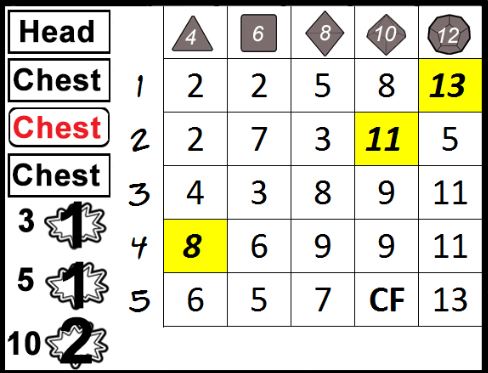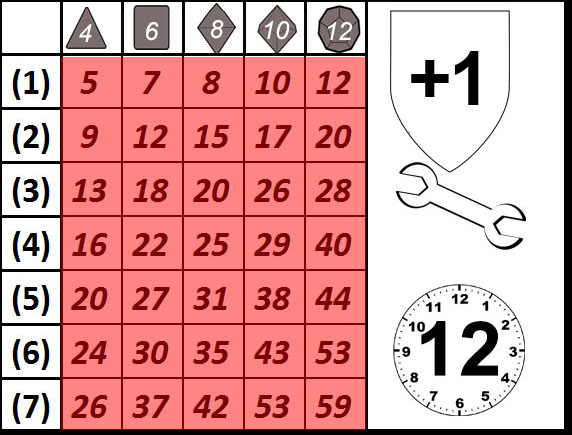Action Cards - Deprecated
This game comes with a set of action cards, capable of resolving actions from simple to complex in seconds. At first glance, all of the entries may seem daunting, but only a subset of the information will be used in each draw. The fundamental rule of action cards is: One action, one card*. This means that no matter how complex the action, everything you need can be found on a single card.
Action cards derive greater value the more complex a task is. Using action cards for a simple skill check takes a couple of seconds, just like a dice roll. But using action cards to resolve a combat situation involving hit, damage, armor, hit location and possible weapon breakage (and other rare situations) also only takes a few seconds, while doing it with die rolls takes significantly longer. One advantage it offers is that the rarely used rules, like equipment failure and unintended targets, are automatically checked with no extra effort, and stand out when relevant. No extra effort is required from the player.
*There are rare cases when subsequent draws can occur, but they are not mandatory. These additional draws do not increase the complexity of the action, only the magnitude of the result.
Contents
[hide]Card Anatomy
Action cards are divided into three sections: upper results, lower results and outer edge. Upper results are often referred to as causes, lower results are effects. For example, determining whether a skill is used successfully is an upper result: a cause. Determining the damage a handgun deals to an opponent is a lower result: an effect.
Binary Skill Check
This is the simplest type of action, yet it is also very common. Some examples of binary skill checks are: Can I climb this tree in time? Can I pick this lock? Can I jump across this chasm? Any check that returns a pass/fail result is a binary skill check. Binary skill checks exclusively use the upper results section of the card.
To resolve a binary skill check, find the appropriate die type column and cross-reference the number of dice in the pool. The result is any entry in the given square or higher in the appropriate row. In effect, each square is one die. In this example card, 3d8 could choose 5, 3 or 8.
Example: Sid Scorpio is attempting to outrun a Kyr commando on (some planet) and he comes to a deep crevice in the rock, with a 50 meter fall to a craggy doom below. He knows his only chance is to jump, so he declares his intention. The card is drawn and compared to his attribute of 3d8. In the d8 column the results are 5, 3 and 8. He chooses 8 and compares it to the TN of 7. A success.
That is it! In a simple task like this, nothing else on the card is relevant.
Skill Check With Degrees of Success
More complicated skill checks often involve both a pass/fail element as well as a magnitude of success. They could be instant results like in combat, or extended tasks like decoding a cryptogram or hastily constructing shelter before the storm arrives. Some examples are: I hit, but how much damage? I made my computer roll, how much programming do I get done?
To resolve a skill check with degrees of success, follow the procedure above to determine if the attempt is successful. If it is, find the appropriate row and column pair on the lower results. Note that in this section, lower rows are always better than higher ones (these results are sums of the given number of dice). The number generated is compared to the complexity of the task (or size of target, if combat). Each multiple of the complexity achieves 1 success. Extra effect is lost.
Combat is a special case. Instead of complexity, each target has a size value. Compare the effect points to this number. Any additional effect is dealt as concussion.
Example: Xenes wishes to bypass a complex security system while trying to escape from a band of pipe wielding thugs. He has a narrow lead, so time is of the essence. The TN of the security system is 5, and the complexity is 6. The Master determines that he needs 3 successes to achieve his goal. He draws a card and checks his Security Systems skill of 4d8, yielding a 9. This is a success!
Now to determine how many successes he achieves. He consults his tools and notes their quality is 5d6. Checking the appropriate box he finds 27, granting him 4 successes at complexity 6. The extra 3 points are lost. However, since he achieved more than the required number of successes, Xenes is able to defeat the security system in one action.
Combat Action
As in most games, combat in Future Imperfect can involve many complex actions and interactions. What follows is a step by step usage of an action card to resolve a complex combat action. All of the following examples refer to this card:
Example 1: Xenes Versus Thugs
After defeating the security system, Xenes enters the secured hallway and moves down the corridor to a supply room, where he finds an unattended blaster rifle. Hearing the thugs enter the door behind him, he turns over a table and takes up position behind it. He will be ready when the thugs barge in.
In the first round, Xenes gets the drop on them and makes his attack. The thugs are not surprised, but they are in the open. The standard TN for a shot is 5, and he decides to fire a burst of 3. He has 4d8 in rifle, so he checks the d8 column and finds 3, 3, 2, 7. His result is 7, a hit. Because he declared a 3 round burst, the 3 section in the lower left of the upper results indicates how many rounds hit. In this case, it is 2.
The next step is hit location. The four rectangles to the left of the upper results are the possible hit locations. Unless told otherwise, use the bold, red result in the box with rounded corners. This is the standard hit location. In this case, it is the left arm.
The thugs are well prepared for a fight, each clad in LBA5. Can the blast rifle penetrate? Here is how you find out. The rifle has a penetration value of x, and the armor has a protection value of y. Add the number in the shield near the lower results to the penetration value of the weapon. In this case it is zero. Because the rifle has a higher penetration than the armor has protection, the shot penetrates.
Next we calculate damage. A blast rifle has a damage value of 3d8. In this case, it does 13 points. Compare that to the size of the thug, 6, and 2 wounds are dealt. In combat extra effect carries over to concussion damage. The thug takes 2 wounds and 1 concussion from this shot.
The second shot is calculated in exactly the same way, except it uses the hit location in the box directly above the standard, in this case, chest.
Finally, beneath the shield in the lower results is an icon of a broken wrench. This is the equipment failure section. The wrench will only be broken if there is a chance for breakage. In this case, there is a number, 11. This is compared to the reliability of the blast rifle which is x. The blast rifle fails, the Master rules it has overheated. This occurs after the shot.


